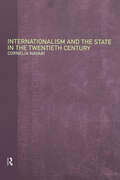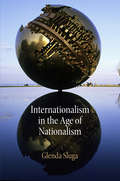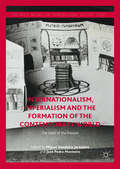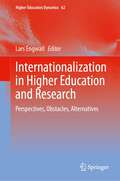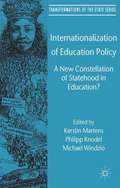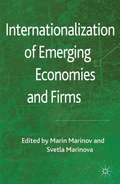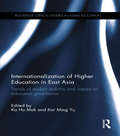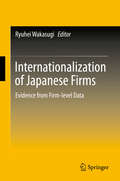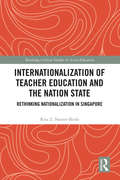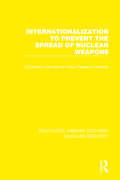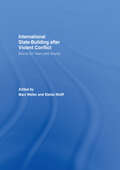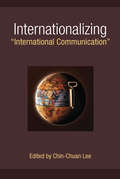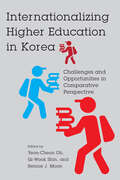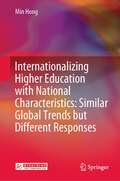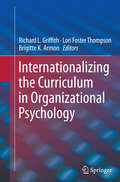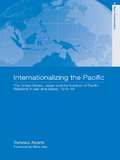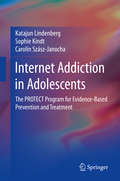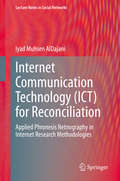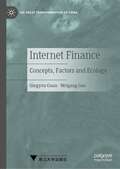- Table View
- List View
Internationalism Toward Diplomatic Crisis: The Second International And French, German And Italian Socialists (Marx, Engels, And Marxisms Ser.)
by Elisa MarcobelliThis book analyzes how the Second International reacted to international diplomatic crises and what was the attitude of French, German and Italian socialists between 1889 and 1915, the year in which Italy entered the World War. This book shows that the Second International became over the years more and more involved in the fight against war and learnt to respond to situations of diplomatic crisis. An example of this is the fact that its last congress before the outbreak of the First World War, the Basel Congress of 1912, was nothing less than a great international socialist demonstration of opposition to war. However, the fact that France, Germany or Italy were involved in a diplomatic crisis hindered the International's ability to respond effectively to it. For all these factors, the attitude of the International is very different from one crisis to another.
Internationalism and the State in the Twentieth Century (The\new International Relations Ser.)
by Cornelia NavariUsing in-depth analysis of power relations, material changes and developments in ideologies, this essential text provides an accessible and student friendly historical introduction to the changing relations between states. The subjects covered include long term trends relating to war, the changing balance of power, decolonisation, the European system and the Cold War. This volume is essential reading for all those interested in the history of International Relations in the twentieth century.
Internationalism in Children’s Series
by Karen Sands-O’connor Marietta A. FrankInternationalism in Children's Series brings together international children's literature scholars who interpret 'internationalism' through various cultural, historical and theoretical lenses. From imperialism to transnationalism, from Tom Swift to Harry Potter, this book addresses the unique ability of series to introduce children to the world.
Internationalism in the Age of Nationalism
by Glenda SlugaThe twentieth century, a time of profound disillusionment with nationalism, was also the great age of internationalism. To the twenty-first-century historian, the period from the late nineteenth century until the end of the Cold War is distinctive for its nationalist preoccupations, while internationalism is often construed as the purview of ideologues and idealists, a remnant of Enlightenment-era narratives of the progress of humanity into a global community. Glenda Sluga argues to the contrary, that the concepts of nationalism and internationalism were very much entwined throughout the twentieth century and mutually shaped the attitudes toward interdependence and transnationalism that influence global politics in the present day.Internationalism in the Age of Nationalism traces the arc of internationalism through its rise before World War I, its apogee at the end of World War II, its reprise in the global seventies and the post-Cold War nineties, and its decline after 9/11. Drawing on original archival material and contemporary accounts, Sluga focuses on specific moments when visions of global community occupied the liberal political mainstream, often through the maneuvers of iconic organizations such as the League of Nations and the United Nations, which stood for the sovereignty of nation-states while creating the conditions under which marginalized colonial subjects and women could make their voices heard in an international arena. In this retelling of the history of the twentieth century, conceptions of sovereignty, community, and identity were the objects of trade and reinvention among diverse intellectual and social communities, and internationalism was imagined as the means of national independence and national rights, as well as the antidote to nationalism.This innovative history highlights the role of internationalism in the evolution of political, economic, social, and cultural modernity, and maps out a new way of thinking about the twentieth century.
Internationalism, Imperialism and the Formation of the Contemporary World
by Miguel Bandeira Jerónimo José Pedro MonteiroThis volume offers innovative insights into and approaches to the multiple historical intersections between distinct modalities of internationalism and imperialism during the twentieth century, across a range of contexts. Bringing together scholars from diverse theoretical, methodological and geographical backgrounds, the book explores an array of fundamental actors, institutions and processes that have decisively shaped contemporary history and the present. Among other crucial topics, it considers the expansion in the number and scope of activities of international organizations and its impact on formal and informal imperial polities, as well as the propagation of developmentalist ethos and discourses, relating them to major historical processes such as the growing institutionalization of international scrutiny in the interwar years or, later, the emerging global Cold War.
Internationalisms
by Glenda Sluga Patricia ClavinThe twentieth century, a time of profound disillusionment with nationalism, was also the great age of internationalism. To the twenty-first-century historian, the period from the late nineteenth century until the end of the Cold War is distinctive for its nationalist preoccupations, while internationalism is often construed as the purview of ideologues and idealists, a remnant of Enlightenment-era narratives of the progress of humanity into a global community. Glenda Sluga argues to the contrary, that the concepts of nationalism and internationalism were very much entwined throughout the twentieth century and mutually shaped the attitudes toward interdependence and transnationalism that influence global politics in the present day. "Internationalism in the Age of Nationalism" traces the arc of internationalism through its rise before World War I, its apogee at the end of World War II, its reprise in the global seventies and the post-Cold War nineties, and its decline after 9/11. Drawing on original archival material and contemporary accounts, Sluga focuses on specific moments when visions of global community occupied the liberal political mainstream, often through the maneuvers of iconic organizations such as the League of Nations and the United Nations, which stood for the sovereignty of nation-states while creating the conditions under which marginalized colonial subjects and women could make their voices heard in an international arena. In this retelling of the history of the twentieth century, conceptions of sovereignty, community, and identity were the objects of trade and reinvention among diverse intellectual and social communities, and internationalism was imagined as the means of national independence and national rights, as well as the antidote to nationalism. This innovative history highlights the role of internationalism in the evolution of political, economic, social, and cultural modernity, and maps out a new way of thinking about the twentieth century.
Internationalization and Canadian Agriculture
by Grace SkogstadIn recent decades, Canada's agricultural industry, one of the world's largest, has had to adjust to global trade developments such as the North American Free Trade Agreement (NAFTA) and the World Trade Organization. Internationalization and Canadian Agriculture examines the patterns of continuity and change in Canadian agricultural policy making in important areas like farm income support programs, prairie grain marketing, supply management, animal and food product safety, and the regulation of genetically modified crops and foods. Arguing that the effects of internationalization have been mediated by Canada's political institutional framework, Grace Skogstad demonstrates how the goals and strategies of authoritative political actors in Canada's federal and parliamentary systems have been decisive to policy developments. Skogstad details the interaction between agriculture and the political economy of Canada, shows how international and domestic trade shape Canadian agricultural policies, and argues that while agricultural programs have changed, the post-war state assistance agricultural paradigm has persisted. A thorough political analysis and history of late twentieth- and early twenty-first-century Canadian agricultural policy and policy-making, Internationalization of Canadian Agriculture is an important contribution to political economy and public policy.
Internationalization in Higher Education and Research: Perspectives, Obstacles, Alternatives (Higher Education Dynamics #62)
by Lars EngwallThis book examines the pros and cons of the internationalization of higher education institutions, which is an important feature of modern universities. It makes a significant contribution to our understanding of universities and an important input to the assessment of the internationalization of higher education institutions both for regulators and for the universities themselves. The book’s three parts focus on a number of issues associated with internationalization. The first part – Perspectives on Internationalization – provides critical reflections on internationalization, on the globally distributed European-American university and on the impact of rankings. The second part – The Obstacles to Internationalization – deals with the significance of language, challenges of mobility and environment concerns. The third part – Alternative Modes of Internationalization – discusses internationalization at home, international distance education and the establishment of international branch campuses.
Internationalization of Education Policy
by Kerstin Martens Michael Windzio Philipp KnodelThis book investigates and discusses the phenomenon of internationalization of education policy and its consequences for national policymaking processes. By comparing educational outcomes and actors' reactions in different countries, it provides detailed insights into a highly contested policy field.
Internationalization of Emerging Economies and Firms
by Svetla Marinova Marin MarinovExplores the impact of country and firm specific factors, the role of institutions and governments, the strive for compensation of initial disadvantages and the struggle in finding ways to counterbalance late coming into the international arena in the process of internationalization.
Internationalization of Higher Education and Digital Transformation: Insights from Morocco and Beyond
by Aicha AdouiThis edited volume provides a comprehensive examination of the intersection between internationalization of higher education and digital transformation, with a focus on insights from Morocco. Through a series of chapters authored by experts in the field, the book covers a wide range of topics, including critical thinking in intercultural education, the transformative impact of internationalization on educators and students, technological integration, challenges, opportunities, policy perspectives, and future directions.
Internationalization of Higher Education in East Asia: Trends of student mobility and impact on education governance (Routledge Critical Studies in Asian Education)
by Ka Ho Mok Kar Ming YuThe rise in demand for higher education in the Asia-Pacific region is an undeniable reflection of the growing pace of globalization and the subsequent pressures imposed by it. Aspiring to become globally competitive and to position favourably in the global university league tables, governments in Asia have either engaged in a serious quest to become a regional education hub or they have concentrated on developing transnational higher education to create more opportunities, in order to meet their citizens’ pressing demand for higher education. Internationalization of Higher Education in East Asia critically examines and provides comparative perspectives on the major strategies that selected Asian countries and societies have adopted to transform their higher education sector and enhance their national competitiveness in the increasingly globalized world. This volume by leading scholars in the field of education development and policy studies makes critical reflections on how Asian governments in particular and universities in general have responded to the growing challenges of globalization by promoting more internationalization, student mobility and entrepreneurship in higher education. This book is an essential collection for policy makers, researchers and postgraduate students studying higher education, Asian education and international education.
Internationalization of Japanese Firms
by Ryuhei WakasugiThis book takes a comprehensive look at Japanese firms engaging in export and foreign direct investment (FDI) and develops new methods and data to investigate the internationalization of firms, which is a focus issue in international trade. Using micro-level data, the book provides an introduction to theoretical and statistical analysis of internationalization modes of Japanese firms with productivity heterogeneity. It makes clear that although the productivity of internationalized Japanese firms is higher on average than that of firms serving only the domestic market, the difference in productivity between exporters and FDI firms is not as obvious in comparison with that of their counterparts in the United States and Europe. Focusing on this point, the book analyzes not only productivity heterogeneity among firms, but also the differences in firm-specific factors other than productivity: industry-specific factors, market-specific factors such as market size and variable and fixed costs for export, and FDI in destination countries. This in-depth investigation reveals how those factors make the modes of Japanese firms' internationalization different from those in the United States and Europe. Further analysis focuses on the effects of match quality, organizational and institutional factors in the market on firms' exports, and FDI. As an approach to the current trends in international trade, this book is unique in using detailed firm-level panel data drawn from Japanese government statistics.
Internationalization of Teacher Education and the Nation State: Rethinking Nationalization in Singapore (Routledge Critical Studies in Asian Education)
by Rita Z. Nazeer-IkedaThe relationship between teacher education and internationalization is often regarded as one that has just begun, sparked by globalization and its knowledge economy. This book questions such an assumption by arguing that although contemporary demands on teacher education have intensified the need for internationalization, teacher education and internationalization have a deep and complex relationship, which is context dependent and has developed differently over time. This book urges its readers to question and rethink overly nationalistic approaches to teacher education. It shows how the internationalization of teacher education could be used as a strategic tool to support sustainable educational development and meet labor market demands for twenty-first century competencies. It puts the spotlight on the imperatives for internationalizing teacher education and its present forms, and considers this current phenomenon in the context of Singapore. This nation state has a history of internationalization, albeit with differing rationales, dimensions and strategies. Internationalization has been a key driver of the Singapore education system’s sustained growth, from its humble beginnings to its present state as one of the best performing education systems in the world. This book will be of great interest to policy makers, academics, researchers and graduate students in the fields of international and comparative education, teacher education, and South East Asian studies.
Internationalization to Prevent the Spread of Nuclear Weapons (Routledge Library Editions: Nuclear Security)
by Stockholm International Peace Research InstituteFirst published in 1980, the original blurb read: In August – September 1980 the second Review Conference of the Non-Proliferation Treaty (NPT) will take place in Geneva. As this Treaty is the most important barrier to the proliferation of nuclear weapons, the results of the Conference will obviously have major effects in the field of arms control and disarmament. The implications of the recent International Nuclear Fuel Cycle Evaluation (INFCE) are that the technological capabilities of many countries are such that there is no technical solution to the problem of the spread of nuclear weapons to countries that do not now have them. Thus, it appears that if there is a solution at all, it must be political in nature. A possible element in such a political solution is the internationalization of the sensitive parts of the nuclear fuel cycle; that is, those parts that have the potential of producing fissile materials to make nuclear weapons. Although the intricacies of a system of internationalization are still unresolved, the concept, if realized, would provide another powerful political barrier to nuclear weapon proliferation – a reinforcement for the aims of the NPT itself. Against this background, and as a follow-up to its first symposium and the resultant book, Nuclear Energy and Nuclear Weapon Proliferation, SIPRI convened a second international group of experts to continue its discussions of issues pertinent to the forthcoming NPT Review Conference. The meeting took place at SIPRI in Stockholm, 31 October – 2 November 1979, when the feasibility of internationalizing the nuclear fuel cycle was examined. SIPRI’s views on this complex approach are expressed in Part 1 of this book - Internationalization to Prevent the Spread of Nuclear Weapons. Part 2 contains the papers that were presented at the symposium.
Internationalized State-Building after Violent Conflict: Bosnia Ten Years after Dayton (ISSN)
by Stefan Wolff Marc WellerPreviously published as a special issue of Ethnopolitics, this volume analyzes various dimensions of the internationalized state-building process in Bosnia and Herzegovina since 1995. In December 1995, the Dayton Agreements ended the war in Bosnia and Herzegovina and established a fragile peace between the former conflict parties. The settlement seemed morally wrong and politically impracticable, but still necessary in order to end violence of a scale and intensity not seen in Europe since the end of the Second World War. The leading contributors conclude that internationalized state-building can only serve well in the stabilization of states emerging from conflict if it draws on a well-balanced approach of consociational techniques, moderated by integrative policies, tempered by a wider regional outlook and sustained by resourceful and skilled international involvement. The experience of Bosnia and Herzegovina may not have scored full marks in all of these categories, but important lessons can be gleaned for other similar contemporary and future challenges that the international community no doubt will have to face.This book will be of interest to students and scholars of international organizations, civil wars and ethnic conflicts, international law and peace studies.
Internationalizing "International Communication"
by Chin-Chuan LeeInternational communication as a field of inquiry is, in fact, not very "internationalized." Rather, it has been taken as a conceptual extension or empirical application of U.S. communication, and much of the world outside the West has been socialized to adopt truncated versions of Pax Americana's notion of international communication. At stake is the "subject position" of academic and cultural inquirers: Who gets to ask what kind of questions? It is important to note that the quest to establish universally valid "laws" of human society with little regard for cultural values and variations seems to be running out of steam. Many lines of intellectual development are reckoning with the important dimensions of empathetic understanding and subjective consciousness. In Internationalizing "International Communication," Lee and others argue that we must reject both America-writ-large views of the world and self-defeating mirror images that reject anything American or Western on the grounds of cultural incompatibility or even cultural superiority. The point of departure for internationalizing "international communication" must be precisely the opposite of parochialism - namely, a spirit of cosmopolitanism. Scholars worldwide have a moral responsibility to foster global visions and mutual understanding, which forms, metaphorically, symphonic harmony made of cacophonic sounds.
Internationalizing Higher Education in Korea: Challenges and Opportunities in Comparative Perspective
by Yeon-Cheon Oh, Gi-Wook Shin, and Rennie J. MoonStudent mobility in Asia has reached unprecedented levels. Inbound and outbound student mobility creates opportunities for Asian societies but also challenges, such as growing diversity and brain drain. This book examines these and other related, timely issues for the case of South Korea, a major player in the internationalization of higher education in Asia, and draws on the comparative experiences of other key players in the Asia-Pacific region—Japan, China, Singapore, and the United States. By doing so, it offers critical perspectives on the internationalization of Korean higher education as well as innovative, policy-relevant solutions for Asian countries undergoing similar challenges. It will be a valuable addition to the growing literature on comparative and international education in Asia and can aid university administrators and policymakers striving to internationalize their higher education systems to meet new challenges.
Internationalizing Higher Education with National Characteristics: Similar Global Trends but Different Responses
by Min HongIn an era of globalization, internationalization of higher education (IHE) has been constructed as an almost inevitable trend and has become a common pursuit of many nations in their higher education (HE) policies. This book focuses on two nations, China and Australia, in terms of this trend. The broadest aim of this book was to find out the interactive relationships between global and national pressures in policy development by comparing the international HE policies in China and Australia. The three categories, overarching meta-policies at the macrolevel (nation), institution focused policies at the mesolevel (universities), and people focused policies at the microlevel (individuals) are documented and analyzed. Similarities and differences are identified. Similarities include promoting and deepening IHE as one important agenda in national policies at the macrolevel in the two nations, promoting transnational cooperation in the provision of HE at the mesolevel, as well as increasing international student numbers and encouraging an outflow of student learning and exchanges at the microlevel. Differences include China’s soft power initiatives and Australia’s appeal for the sustainability of international HE as a national priority in the area of IHE at the macrolevel; the focus on “World Class Universities” construction in China and strengthening the overall HE system in Australia; and different issues in relation to people mobility and brain circulation—specifically, encouraging more outflow of students and attracting more inflow of talents and international students in China, and over-reliance on international students financially in Australia. It is suggested that different responses to the global trends reflect the specificities of each nation and the ways path-dependent factors mediate global pressures. This comparison will facilitate a better understanding of how globalization has affected and been responded to in IHE policies and enable a better understanding of their path-dependent mediation through a focus on two specific sets of national policies.
Internationalizing the Curriculum in Organizational Psychology
by Richard L. Griffith Lori Foster Thompson Brigitte K. ArmonThis book assembles state-of-the-art thinking on the internationalization of the curriculum of training centers in I/O and Work Psychology. The experts contributing chapters share their thoughts on the knowledge and skills that students must master in the 21st century, as well as their research on how we can develop students to be globally perceptive, culturally competent working professionals. Chapters cover a full range of topics such as: the scope of subject matter and content, learning objectives and outcomes, global competencies, co-curricular activities, experiential learning and the tacit curriculum, while curriculum development must stem from the philosophy of each institution, these philosophies may diverge in focus (e. g. science versus practice) and outcomes (e. g. jobs versus mastery). Therefore, the goal of the book is not to prescribe a particular curriculum, but rather to provide insight on possible curriculum elements that may be customized for use by training institutions.
Internationalizing the Pacific: The United States, Japan and the Institute of Pacific Relations, 1919-1945 (Routledge Studies in Asia's Transformations)
by Tomoko AkamiThe Institute of Pacific Relations was a pioneering intellectual-political organization that shaped public knowledge and both elite and popular discourse throughout the Asia-Pacific region and beyond during the inter-war years. Inspired by Wilsonian internationalism after the 1919 formation of the League of Nations, it grew to become an international and national non-governmental think-tank providing expertise on Asia and the Pacific. This book investigates post-League Wilsonian internationalism with respect to two critical issues: the nation state and the conception of the Asia-Pacific region; both issues broach a range of contentious subjects including colonialism, orientalism, racism and war. Akami's study of the Institute of Pacific Relations offers insight into the formation of the dominant ideologies and institutions of regional and international politics in the Pacific during the inter-war years, and provides an interesting perspective on Japan's relations with countries including the USA and Australia.
Internet Addiction in Adolescents: The PROTECT Program for Evidence-Based Prevention and Treatment
by Katajun Lindenberg Sophie Kindt Carolin Szász-JanochaThis book presents a new, evidence-based cognitive behavioral intervention for the prevention and treatment of Internet addiction in adolescents. It provides a comprehensive overview of the current state of research regarding phenomenology, diagnostics, epidemiology, etiology, and treatment and prevention of Internet addiction as a new behavioral addiction. The book is divided into two sections. The first part of the book explores various bio-psycho-social factors that contribute to the development and maintenance of symptoms in young individuals. Chapters in the second part of the book discuss the PROTECT intervention to reduce Internet addiction in adolescents. PROTECT aims to modify risk factors and maintenance factors, specifically, boredom and motivational problems, procrastination and performance anxiety, social anxiety and maladaptive emotion regulation. The PROTECT intervention is a low-intensity approach which uses comprehensive case examples in order to increase cognitive dissonance and treatment motivation. In addition, PROTECT contains cognitive behavioral intervention techniques such as psychoeducation, behavior activation, cognitive restructuring, problem solving and emotion regulation. Topics featured in this book include:Adolescence and development-specific features of Internet addiction.An overview of modifiable risk factors and maintenance factors of Internet addiction.Environmental factors that affect the development of Internet addiction.Online and offline video gaming addiction. Social network addiction.Strategies that work in prevention and treatment. Internet Addiction in Adolescents is a must-have resource for researchers, professors, clinicians and related professionals as well as graduate students in clinical child, school, and developmental psychology, educational policy and politics, and social work as well as related disciplines.
Internet Communication Technology: Applied Phronesis Netnography in Internet Research Methodologies (Lecture Notes in Social Networks)
by Iyad Muhsen AlDajaniThe book explores Applied Phronesis in internet communication technology and Netnography application, introducing it on Facebook and YouTube usages. It defines two pillars for the research dynamics, “Episteme” and “Techne.” – the know-how, how-to, and the power dynamics. The “Episteme” explores the dynamics of reconciliation in the middle of conflict, Internet communication technologies for transformation, Moderation in Islam, online Deliberative Democracy.The second pillar, “Techne,” is explored through Internet communication technology for the advancement of reconciliation in the middle of a conflict.The book describes the Phronetic Approach in internet research in academic discourse adopting Phronesis “an Aristotelian concept and method defined by Bent Flyvbjerg,” and exploring Netnography for Kozinets, in Mixed-Method research design and applying methodological triangulation in research and testing the hypothesis using qualitative content analysis for Krippendorff, developing a methodological discourse for interdisciplinary research using internet communication technologies as part of understanding big-date, introducing Applied Digital Humanities.
Internet Election Campaigns in the United States, Japan, South Korea, and Taiwan
by Diana Owen Shoko Kiyohara Kazuhiro MaeshimaThis book investigates how institutional differences, such as the roles of political parties and the regulation of electoral systems, affect the development of Internet election campaigns in the U. S. , Japan, Korea, and Taiwan. It examines whether or not the "Americanization of elections" is evident in East Asian democracies. While Japan is a parliamentary system, the U. S. and Korea are presidential systems and Taiwan is a semi-presidential system that has a president along with a parliamentary system. Furthermore, the role of the presidency in the U. S. , Korea, and Taiwan is quite different. Taking these variations in political systems into consideration, the authors discuss how the electoral systems are regulated in relation to issues such as paid advertisements and campaign periods. They argue that stronger regulation of election systems and shorter election periods in Japan characterize Japanese uniqueness compared with the U. S. , Korea, and Taiwan in terms of Internet election campaigns.
Internet Finance: Concepts, Factors and Ecology (The Great Transformation of China)
by Qingyou Guan Weigang GaoThis book summarizes recent Chinese discussions about Internet finance—a new financial business type resulting from an innovative thinking under the new normal—in the light of the actual situation of China in transformation, especially the thirst of the grass-roots economy including medium-small and micro-sized enterprises as well as residents for financial services. The Internet finance is of great significance for optimizing and upgrading the industrial structure, improving the demand structure and reshaping the economic growth mode in China. This book will interest scholars, journalists, and businesspeople.

